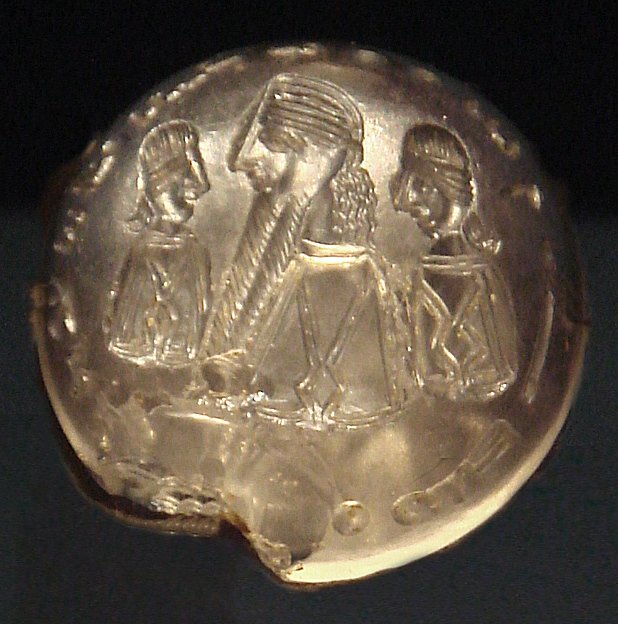Mani (circa 216-274 CE) was a Persian prophet and the founder of Manichaeism, a syncretic religious movement that emerged in the 3rd century CE. Born in the Parthian Empire, Mani’s teachings combined elements of Zoroastrianism, Christianity, and Buddhism, creating a distinctive dualistic framework that emphasized the cosmic struggle between light and darkness. He claimed to be the final prophet in a line that included Zoroaster, Buddha, and Jesus, seeking to harmonize and fulfill their messages. Manichaeism spread widely across the Roman Empire, Central Asia, and China, gaining a significant following before eventually declining due to persecution and competition with other religious traditions. Mani’s writings, including the Shabuhragan and Kephalaia, were foundational to his teachings and provide insight into his vision of a universal religion. Despite its decline, Manichaeism’s influence on religious thought and its role in the transmission of ideas across cultures are notable.
Early Life and Background
Mani was born on April 14, 216 CE, in or near Ctesiphon, the capital of the Sasanian Empire, which is modern-day Iraq. His father, Pattig or Patek, was a member of the Elcesaites, a Gnostic sect that emphasized asceticism and mystical practices. Mani’s mother, Maryam, was of Parthian descent, adding a layer of cultural and religious diversity to his upbringing.
The young Mani was raised within the Elcesaite community, where he was exposed to a blend of Jewish, Christian, and Zoroastrian ideas. This early exposure to various religious traditions deeply influenced Mani’s later teachings. From a young age, Mani exhibited a strong inclination toward spiritual matters, often engaging in contemplative practices and seeking deeper understanding of the divine.
At the age of 12, Mani experienced his first divine revelation. He claimed that a celestial twin, a divine figure he referred to as the “Syzygos” or “Twin,” appeared to him, revealing the truth about the nature of the world and the path to salvation. This event marked a turning point in Mani’s life, setting him on a path of spiritual discovery that would eventually lead to the foundation of a new religious movement.
Spiritual Journey and Revelation
Mani’s revelations were not confined to his early years. At the age of 24, he received a second, more profound revelation, in which the Syzygos instructed him to leave the Elcesaite community and proclaim a new religion to the world. Mani was now convinced that he had been chosen as a prophet, destined to bring a final and universal religion that would complete the partial truths of earlier religious traditions.
He began to preach his new doctrine, emphasizing the dualistic nature of existence. According to Mani, the world was a battleground between two eternal principles: Light and Darkness. The realm of Light was the domain of the divine, associated with knowledge, purity, and goodness, while the realm of Darkness was characterized by ignorance, materialism, and evil. Human beings, according to Mani, were caught in this cosmic struggle, and the purpose of life was to liberate the soul from the bondage of the material world and return it to the realm of Light.
Mani’s teachings were deeply influenced by his knowledge of other religious traditions. From Zoroastrianism, he adopted the concept of dualism and the cosmic struggle between good and evil. From Christianity, he borrowed the idea of a savior figure, positioning himself as the final prophet in a line that included figures like Zoroaster, Buddha, and Jesus. Mani also incorporated elements of Buddhist thought, particularly the emphasis on asceticism and the renunciation of worldly desires.
Foundation of Manichaeism
Manichaeism, as a religious system, was meticulously organized and well-documented. Mani composed several key texts, including the “Shabuhragan,” written in Middle Persian and dedicated to the Sasanian king Shapur I, and other scriptures like the “Gospel of Mani” and the “Epistles.” These texts laid out the core beliefs of Manichaeism, including the nature of the cosmos, the role of the soul, and the path to salvation.
The Manichaean community was structured hierarchically, with a clear distinction between the “Elect,” who were the spiritual elite, and the “Hearers,” who were lay followers. The Elect were expected to adhere to strict ascetic practices, including celibacy, vegetarianism, and the renunciation of material possessions. The Hearers, while not bound by the same rigorous standards, were encouraged to support the Elect and follow the teachings of Mani as closely as possible.
Mani’s teachings spread rapidly, aided by his extensive travels and the missionary efforts of his followers. He is known to have traveled throughout the Sasanian Empire, as well as to regions beyond, including India, Central Asia, and possibly even China. Mani’s ability to adapt his message to different cultural contexts, coupled with the universal appeal of his dualistic worldview, helped Manichaeism gain a significant following across a vast geographical area.
Mani’s Missionary Work
Mani’s missionary work was marked by both success and challenges. He sought to win the favor of the Sasanian rulers, particularly Shapur I, who is said to have shown some interest in Mani’s teachings. However, Mani’s relationship with the Zoroastrian priesthood, who wielded significant influence in the Sasanian court, was far more contentious. The Zoroastrian clergy viewed Mani’s teachings as heretical, and their opposition would eventually lead to his downfall.
Despite these challenges, Mani’s teachings continued to spread. His followers established Manichaean communities across the Roman Empire, North Africa, Egypt, and even as far as China, where the religion gained a foothold along the Silk Road. Mani’s message resonated with people from diverse backgrounds, offering a comprehensive and coherent explanation of the human condition and the nature of the universe.
Mani also engaged in theological debates with representatives of other religious traditions. He viewed his teachings as the fulfillment of the truths found in Zoroastrianism, Christianity, and Buddhism, positioning Manichaeism as the final, universal religion. However, this claim also brought him into conflict with adherents of these faiths, who viewed Mani’s teachings as a distortion or usurpation of their own.
Persecution and Death
The rise of Manichaeism was met with increasing hostility from the Zoroastrian clergy, who saw the new religion as a direct threat to their authority and the religious unity of the Sasanian Empire. Mani’s teachings, which incorporated and reinterpreted elements of Zoroastrianism, were viewed as particularly dangerous. The Zoroastrian high priests, or Magi, were determined to suppress the spread of Manichaeism.
Mani’s situation became increasingly precarious after the death of Shapur I, who had offered him some degree of protection. Under the rule of Bahram I, the Zoroastrian clergy gained greater influence, and they pressured the king to take action against Mani. In 274 CE, Mani was arrested and imprisoned. After a lengthy trial, in which he was accused of heresy and misleading the people, Mani was sentenced to death.
According to Manichaean tradition, Mani endured his imprisonment with great dignity, continuing to teach and inspire his followers until the end. He is believed to have died in prison, possibly through crucifixion or flaying, around 276 CE. His death was seen by his followers as a martyrdom, and Mani was revered as a prophet who had sacrificed his life for the truth.
Manichaeism After Mani
After Mani’s death, his followers continued to spread his teachings, despite ongoing persecution. Manichaeism reached its peak in the 4th and 5th centuries, becoming a major religious force in the Roman Empire, Central Asia, and China. However, the religion faced increasing opposition from both the Christian Church and the Zoroastrian clergy, leading to its gradual decline in the West.
In the East, Manichaeism managed to survive for several more centuries, particularly in Central Asia and China, where it influenced the development of other religious traditions, including Buddhism and Taoism. Manichaean texts were translated into several languages, including Greek, Latin, Coptic, Syriac, and Chinese, ensuring that Mani’s teachings continued to be studied and debated long after his death. The survival and spread of these texts played a crucial role in preserving Mani’s teachings, allowing his ideas to reach diverse cultures and influencing religious thought across different regions. These translations also contributed to the syncretic nature of Manichaeism, as local interpretations and adaptations of Mani’s teachings began to emerge.
The Influence of Manichaeism on Other Religions
Manichaeism’s dualistic worldview, with its clear distinction between the forces of Light and Darkness, resonated with many religious traditions. In the Christian world, especially within the Roman Empire, Manichaeism was initially perceived as a serious rival to Christianity. The religion’s organized structure, its missionary zeal, and its claim to be the ultimate truth posed a challenge to early Christian leaders. As a result, the Church Fathers, including Augustine of Hippo, who himself was a Manichaean for nine years before converting to Christianity, wrote extensively against the religion.
Augustine’s anti-Manichaean writings played a significant role in shaping the Christian response to the sect, emphasizing the perceived heretical nature of its teachings. However, despite these efforts, elements of Manichaean thought found their way into various Christian sects and Gnostic movements, particularly in the way these groups conceptualized the struggle between good and evil.
In the East, Manichaeism had a profound impact on Buddhism, especially in Central Asia and China. The religion’s ascetic practices, its cosmology, and its emphasis on the liberation of the soul influenced certain Buddhist sects, leading to a cross-pollination of ideas. Manichaeism’s influence can be seen in the development of Pure Land Buddhism, with its focus on the dichotomy between the material world and the pure, transcendent realm of the Buddha.
In China, Manichaeism was officially recognized during the Tang Dynasty, albeit as a foreign religion. Known as “Moni Jiao” (the religion of Mani), it was regarded with suspicion by the Confucian state, but it nonetheless managed to attract followers. Manichaean temples were established, and the religion was practiced by some Chinese elites, although it remained a minority faith.
Decline and Suppression of Manichaeism
Despite its early successes, Manichaeism faced increasing persecution as it expanded. In the Roman Empire, the religion was outlawed by Emperor Diocletian in 297 CE, who issued a decree condemning it as a dangerous foreign cult. The decree led to widespread persecution, with Manichaean communities being driven underground or forced to convert to Christianity.
The spread of Islam in the 7th century also marked a turning point for Manichaeism. In the Islamic world, Manichaeism was generally tolerated at first, as the early Islamic rulers recognized the religion as a form of “People of the Book” due to its connections to earlier Abrahamic traditions. However, as Islamic orthodoxy solidified, Manichaeism began to be viewed with suspicion, and by the 10th century, it was largely suppressed in Islamic territories.
In China, the fall of the Tang Dynasty and the rise of the Song Dynasty led to the gradual decline of Manichaeism. The new Confucian authorities were less tolerant of foreign religions, and Manichaeism, along with other non-Chinese faiths, was increasingly marginalized. By the end of the Song period, Manichaeism had largely disappeared from China, surviving only in small, isolated communities.
Legacy and Modern Perspectives
Although Manichaeism as an organized religion eventually faded, its legacy endured in various forms. The dualistic principles of Manichaeism continued to influence Christian thought, particularly in the medieval period, when various heretical movements, such as the Cathars in southern France, adopted similar ideas. The Cathars, like the Manichaeans, believed in the existence of two opposing forces governing the universe, and their doctrines were condemned by the Catholic Church as Manichaean heresy.
The rediscovery of Manichaean texts in the 20th century, particularly through archaeological finds in Egypt, China, and Central Asia, has renewed scholarly interest in the religion. These texts have provided valuable insights into the teachings and practices of Manichaeism, revealing the complexity and depth of Mani’s thought. Scholars have also explored the ways in which Manichaeism interacted with other religious traditions, shedding light on the religious and cultural exchanges that took place along the Silk Road.
Today, Manichaeism is recognized as one of the most significant religious movements of the ancient world. Its emphasis on the cosmic struggle between Light and Darkness, its integration of multiple religious traditions, and its global reach make it a unique and important subject of study in the history of religions. Mani himself is remembered as a visionary prophet who sought to synthesize the religious knowledge of his time into a comprehensive and universal doctrine.





